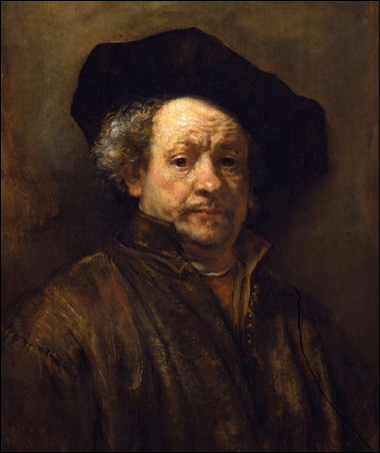But one of the great things about a blog is that here, I don’t need to! So I’m just going to say it: Thomas Kincade makes me sick!! Is this what passes for art in the age of Celebrity Rehab and Bridezillas?
I know I've talked about my contempt for Kincade before. It's not that I'm out to get him or anything. It's not just that he reminds me of Dr. Phil, or that he's full of himself and self-righteous--all of which is true. Sarah Palin liking his work was just a bonus. One of the reasons I am so anti-Kincade, though, is because he touts himself as “The Painter of Light.” On some level, he has to do that to antagonize people. Or maybe it’s just to antagonize people who love art.
Let me tell you about the real Painters of Light. Foremost among them is Caravaggio, the hyperactive, brilliant Baroque-era Milanese master whose lover was a prostitute and whose passionate nature led him to murder (he received a papal pardon—three days after his death). More than four centuries later, all that is almost incidental.

Caravaggio was undoubtedly a genius. His use of chiaroscuro, a painting technique that gives the illusion of light and dimension by creating distinct shadows and contrasts (it literally translates from Italian as “light-dark”), is probably as close to perfection of the technique as Da Vinci’s use of sfumato (think of the subtle gradations of tone and color—and lack of clear lines—in the Mona Lisa). Chiaroscuro is a technique that is used often--as it has been since the Renaissance--but rarely (if ever) as convincingly or as masterfully as in Caravaggio's work.

Chiaroscuro can be used to achieve a variety of effects. In religious paintings of the 16th and 17th centuries, it sometimes served to "illuminate" holy subjects and to depict a Divine inner light emanating from a Biblical figure, as with, for instance, the Baby Jesus. In other paintings, it simply served to simulate light, like candlelight, firelight, or moonlight, and to cast the primary subject of a painting in the spotlight, so to speak.

Caravaggio's paintings are sometimes religious, sometimes secular, but almost always intense and emotional (see above). Caravaggio was also important in the development of tenebrism, a dramatic or extreme variation of chiaroscuro, which gives the illusion of people and objects coming out of darkness and into light.
Rembrandt was a master of chiaroscuro and was also, of course, a master--some would say the master--of portraiture. I prefer Caravaggio to Rembrandt when it comes to his use of chiaroscuro, but that's just a matter of personal taste. If you look at a Rembrandt painting, though, particularly of elderly people, you will see that every detail of the skin seems illuminated. You can almost feel the flesh in a Rembrandt portrait. A young person with fresh, dewy skin and rosy cheeks may be a pleasure to paint, but an elder, with wrinkles and crevices and other interesting features, must be so much more of a challenge. And Rembrandt did it better than anyone. Check out his self-portraits--he must have had an incredibly secure sense of self to paint himself, as he did, both in youth and in old age.


Then there is Vermeer. Everybody knows Vermeer now because of Girl With a Pearl Earring, aka, the "Mona Lisa of the North." The fact that the book and movie made people who'd never heard of the Baroque Dutch Master delve deeper into his work is wonderful. I love Vermeer, not just because of the gorgeous colors--particularly the rich blues; he used pure, gorgeous pigments like lapis lazauli--but because they emimnate warmth. They are drenched in light--natural, glowing, warm, soft light. He also portrays people of his time doing simple, everyday things. My very favorite Vermeer painting--and one of my favorite paintings overall--is The Milkmaid, circ. 1658. Look at the beautiful, vibrant colors, the look of serenity on the milkmaid's face, the simplicity and tranquility of the scene--though it is mundane. I just love it.

Chiaroscuro is something we, today, take for granted, which is understandable: for us, it's always been here. A good way to appreciate chiaroscuro is to look at paintings that came before--look at the flatness, the way figures and people seem to be suspended in space. Then look at paintings that use chiaroscuro--and really think about how the effects were achieved--painstakingly, stroke by stroke. Our tendency is to look at the finished product, as if it were a photograph. And if you look at paintings that way, you're sure to be disappointed. Try to imagine a time before technology; put yourself in that place, if you can, and you will have a better appreciation for the incredible talent and skill needed to pull off this technique.





4 comments:
Thank you for the interesting read. I agree as far as the travesty of Kinkade calling himself a painter of light.
Great post. Thank you.
Thanks for visiting, Michael.
I knew there were more like me that hated Kinkade. The guy has some talent but some talent doesn't make you "the painter of light". I think his grates talent is being a great businessman and finding a great niche to exploit as the religious and art patrons for profit are. Serves them well that the market if flooded with Kinkades and now the paintings are barely worth the frame and canvas they are painted on or rather printed, really.
Post a Comment